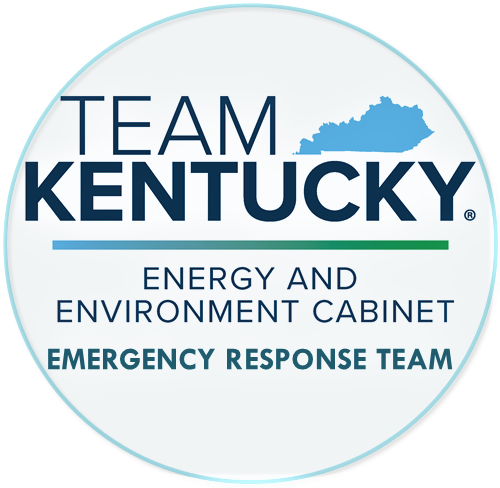Main Content
About the Emergency Response Branch
- What is the Emergency Response Branch (ERB)?
The Emergency Response Branch (ERB) is trained to respond immediately to environmental emergencies where hazardous materials may have been spilled. This team is comprised of and represents the Divisions of Water, Waste Management, and Air Quality for the Department for Environmental Protection during emergency events.
- When should I contact the ERB?
The ERB should be contacted when a release or spill meets or exceeds the reportable quantity as defined in
KRS 224.1-400, the federal list of lists for hazardous materials, and the Clean Water Act.
KRS 224.1-400 also states that ERT should be contacted if a threat of a release or spill could occur that would exceed the reportable quantity. The ERB should be notified when a spill or release or a threatened spill or release of hazardous material, petroleum, pollutant or contaminant occurs or when there appears to be a threat to public health and/or a threat of severe environmental harm. Environmental damage can sometimes be reduced by a quick response and application of appropriate cleanup techniques.
- Who should report hazardous materials spills and when?
Anyone who possesses or controls hazardous substances:
- As listed under the federal Comprehensive Environmental Response Compensation and Liability Act (CERCLA) of 1980, as amended.
- Those extremely hazardous substances designated under Title III of the Superfund Amendments and Reauthorization Act (SARA) of 1986.
- Nerve and blister agents designated under state law.
- Who should report a release of a hazardous material to ERB?
It is the responsibility of the responsible party to report the spill immediately. Anyone who witnesses a "spill" or "release" of any hazardous materials should immediately call the ERB to ensure that the spill is remediated properly.
State law mandates under
KRS 224.1-400 (6): Any person possessing or controlling a pollutant or contaminant for which a reportable quantity has been established by administrative regulation promulgated pursuant to subsection (2) of this section shall immediately notify the cabinet's environmental response line, as soon as that person has knowledge of any release or threatened release, other than a permitted release or application of a pesticide in accordance with the manufacturer's instructions, of a pollutant or contaminant to the environment in a quantity equal to or exceeding the reportable quantity. In the notice to be made to the cabinet, the person shall state, at a minimum, the location of the release or threatened release, the material released or threatened to be released, and the approximate quantity and concentration of the release or threatened release.
- Who should report spills or a release of petroleum?
Reportable quantities (
KRS 224.1-400):
- 25 gallons or more of a petroleum product within a 24-hour period
- 75 gallons or more of diesel fuel in a 24-hour period
- or any amount that creates a visible sheen on surface waters
- Who should I call to report a spill?
You should always call 911 to report a spill. After that, you should notify the Emergency Response Branch, Kentucky Emergency Management, and the National Response Center, if applicable.
- Does calling 911 fulfill my reporting requirement?
No, the Emergency Response Branch does not have a memorandum of agreement with any city or county governments. You should never expect a call to 911 to fulfill your reporting requirements to the state or federal government.
- Does a release into secondary containment constitute a reportable release?
Yes. Any release over the reportable quantity from the primary containment vessel into a secondary containment area is considered a release or a threatened release to the environment.
If the primary containment vessel and the secondary containment area are located inside a building that would not reach the outside environment, then the spill is not reportable to the Emergency Response Branch.
- What happens if I do not report a release?
Under Kentucky law a non-reported release could result in payment of fines up the $25,000 per day per violation.
- Who pays for the services of the ERB?
The party responsible for the release of a hazardous material, whether discharged by accident or through negligence, is liable for the cost of the services.
- Does the ERB respond to other emergencies?
Yes. The Emergency Response Branch is part of the Kentucky Emergency Management, Emergency Operations Plan.
The ERB responds to natural disasters such as floods, tornados and other severe weather, earthquakes, forest fires, landslides that could cause releases of hazardous materials, pollutants, or contaminants. During natural disasters, the ERB helps ensure the stability of hazardous materials and works to limit environmental damage.
The ERB works as a liaison between the Energy and Environment Cabinet and Kentucky Emergency Management during times of drinking water shortages and drought. The ERB also assists the Division of Water during emergencies involving dams.
Relative Content
Environmental Emergency Hotline
1-800-928-2380 or 502-564-2380
Report an Environmental Emergency 24 hours a day, 7 days a week.

Emergency Response Branch
300 Sower Blvd, Frankfort, KY 40601
(502)-782-6893